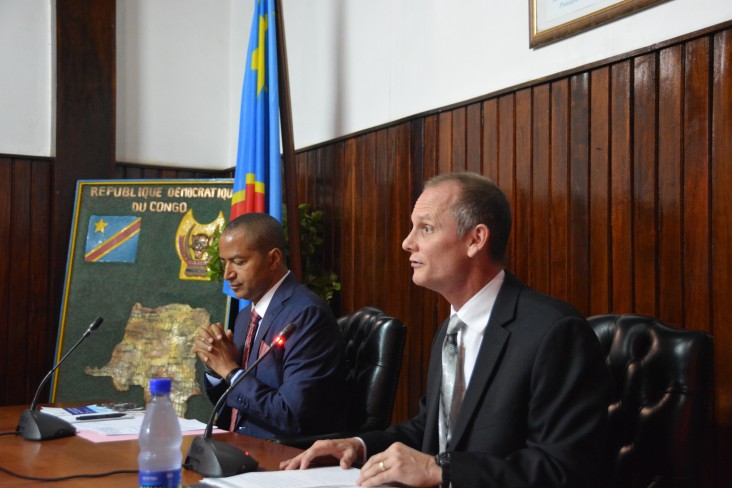
Richard Kimball (right), deputy director of USAID/DRC's Democracy, Human Rights and Governance office, makes opening remarks at a meeting with Katanga Governor Moise Katumbi (left) and cabinet ministers in Lubumbashi.
Kaukab Jhumra Smith/USAID
USAID engages provincial officials on new country development strategy
For Immediate Release
Tuesday, July 14, 2015
Alain Mukeba
+243 81 555 4440
LUBUMBASHI – U.S. government officials are in Lubumbashi this week to introduce the new five-year country strategy for the United States Agency for International Development (USAID) to provincial government authorities in Katanga.
USAID developed a new Country Development Cooperation Strategy (CDCS) for the Democratic Republic of Congo (DRC) for 2015 to 2019 after a long process of consultation and collaboration with DRC government authorities, non-governmental organizations, civil society representatives and international donors. The result is a new cross-sectoral approach to development that builds upon the successes and lessons learned from USAID’s work on health, education, economic growth, and good governance in the DRC over the last 50 years. USAID’s programs in the DRC advance the Agency’s global mission to eliminate extreme poverty and build resilient, democratic societies.
Launched in 2014, USAID/DRC’s new country strategy supports the DRC’s long-term transition to more effective and empowering development. USAID will invest substantially toward three objectives to achieve this goal: 1) that selected national-level institutions more effectively implement their mandates; 2) that lives are improved through coordinated development approaches in select regions; and 3) that the foundation for a durable peace is strengthened in eastern DRC.
To maximize impact, USAID is focusing on bolstering the capacity of targeted government and non-state institutions in a limited number of technical sectors and within a discrete geographic focus. The first development objective focuses on national level institutions. The second development objective focuses on three provinces: Kasai Occidental, Kasai Oriental, and Katanga. The third objective focuses on the conflict-affected areas of eastern DRC: North and South Kivu, northern Katanga, and parts of Maniema and Orientale. In addition, USAID is continuing or establishing programs to address the needs of large urban populations in Kinshasa, Lubumbashi, and Kisangani.
This week’s meeting in Katanga is part of an ongoing outreach campaign by USAID to introduce its country strategy to stakeholders around the DRC. USAID Mission Director Dr. Diana Putman formally presented the country strategy to DRC Prime Minister Augustin Matata Ponyo and key national government officials in June and to provincial government officials in South Kivu last week.







Comment
Make a general inquiry or suggest an improvement.